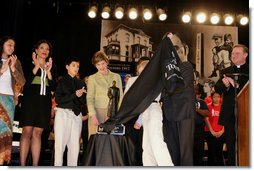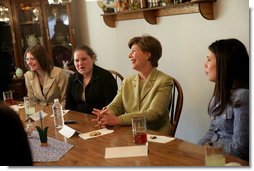
 |
For Immediate Release
Office of the First Lady
April 3, 2006
Mrs. Bush's Remarks at Father Flanagan's Girls and Boys Town
Father Flanagan's Girls and Boys Town
Boys Town, Nebraska
4:03 P.M. CST
MRS. BUSH: Thank you all. Thanks so much, Mayor. Thank you very much. Thank you everybody. Vince, thank you very, very much. Mr. Mayor, thank you for your introduction. Father Boes, thank you so much for hosting me here today at Boys Town. I want to thank everyone, all the adults in the room for all that you do to help children and teenagers at Girls and Boys Town. Your work is vital to helping young people set strong goals for themselves, and then develop the confidence to achieve those goals.
 And I want to thank all the young people in the room for pledging and
practicing to respect yourself and others and for working so hard to
build a successful life.
And I want to thank all the young people in the room for pledging and
practicing to respect yourself and others and for working so hard to
build a successful life.
I also want to acknowledge the Governor. Dave, thank you very much for joining us; and Sally. Congressman Jeff Fortenberry; Congressman Lee Terry; and Congressman Tom Osborne, thank you so much for joining me here today. Attorney General John Bruning is here, and Mayor Jo Dee Adelung, the Mayor of Nebraska City. Thank you very much also for joining us.
I think their presence here shows that they also really care about what happens to children in Nebraska and all across our country.
In his 2005 State of the Union address, President Bush announced the Helping America's Youth initiative, and he asked me to lead it. So over the last year I've traveled to many parts of our country, visiting with young people and with the adults who are important to their lives.
I've been to schools and to after-school programs. I've met with mentors and Big Brothers and Big Sisters. I visited with gang intervention programs, where I met young people who are leaving gangs and finding jobs. I visited a school debate program in Atlanta where students learned to use their voices, and not their fists, to resolve conflict. I recently heard from directors of a program in Los Angeles that I visited last year, which uses the performing arts, performing Shakespeare, to teach youth employable skills. They wrote about Jesus, a young man I met when I was there, who was verging on homelessness. Since then with his experiences building sets with Willpower to Youth, Jesus is now working at Home Depot and was just named the Home Depot Employee of the Month.
Last October, the White House convened a Conference on Helping America's Youth. Scholars, researchers and other adults who work directly with young people shared their research, shared the statistics, the results of programs that many of them had started, anecdotal evidence, and their own experiences. And then we introduced the Community Guide to Helping America's Youth, which I'll talk about in a little bit.
Today I'm on the road still, meeting more people and seeing programs that are making a difference in young people's lives -- places like Girls and Boys Town. There's no doubt about it: Father Flanagan knew what he was doing when he created this model of success nearly 90 years ago.
 And speaking of success, congratulations to the Boys Town Cowboys for
bringing home the basketball state championship. (Applause.) There's
just one way to become a champion: You have to work hard, honor the
team, and believe in yourself. And that's exactly what you did, and it
paid off.
And speaking of success, congratulations to the Boys Town Cowboys for
bringing home the basketball state championship. (Applause.) There's
just one way to become a champion: You have to work hard, honor the
team, and believe in yourself. And that's exactly what you did, and it
paid off.
The Cowboys' victory reminds us that life is a series of ups and downs. That's true for all of us, no matter who we are or where we live. We all have moments of utter happiness. We also have moments of sorrow and fear and loneliness. But without fail, the hard times will pass -- I can assure you of this.
When I look at you students, I see immense promise and possibility in each of you. The adults in this room want you to achieve anything you set your mind to, and they'll follow your success with great pride long after you've left Boys and Girls Town.
When I was growing up in Midland, Texas, it was common for most children to have two parents to rely on. Other caring adults had an equally important place in our lives. I could count on just about every adult in town knowing who I was and what I was doing. And they'd report it to my mother if they saw me doing something they thought I shouldn't.
Of course, young people today face much more difficult challenges. Drugs and gangs, Internet predators, violence in real life and on television are just some of the negative influences in children's lives.
And as today's children face greater dangers, they often have fewer people to rely on. More children are raised in single-parent families, most often without a father. Millions of children have one or both parents in prison. Boys and girls spend more time by themselves or with a group of their peers than with family members, and that often leads to poor choices about alcohol and drugs.
Young people need positive influences in their lives. We want every child to be surrounded by caring adults who provide love, advice, and encouragement, and who can serve as good role models. Through the Helping America's Youth initiative, we're taking action in the most important parts of a child's life -- family, school and community.
Families are the foundation of every child's life. And we must do all we can to help families stay together. We are here today with one very big family -- the parents and the children of Girls and Boys Town. Here, and in many sites around the country, children are nurtured in a safe, family-like environment, where they can learn how to develop healthy relationships, where they can build their moral and spiritual foundations; where boys and girls can acquire social skills and cognitive skills, and practice making wise decisions that will serve them well throughout their lives.
Next, schools are at the heart of helping America's youth, because every child must have a good education to have a bright future. Today our schools are improving, thanks to accountability, to higher standards, and to the hard work of teachers and principals who bring out the very best in their students.
Earlier today I visited a school in Albuquerque, new Mexico, that's incorporating into their curriculum a program started by Mothers Against Drunk Drivers, that helps children avoid risky behaviors like alcohol use. Research shows that the risk for alcohol and drug use dramatically increases in the 6th grade, so it's important to reach children with meaningful, age-appropriate messages before they reach that decision point in life.
"Protecting You/Protecting Me" teaches elementary school-age children about the dangers of using alcohol and drugs before children encounter situations that lead to those dangerous activities. And later, when they do face those decisions, they'll be confident and prepared to make wise choices.
A child's community is the third major part of life. Strong communities support families, so that parents will know the values they teach their children at home will be reinforced when children are outside the home. Strong communities bolster the work of schools by providing educational and safe after-school activities for students. And strong communities nurture healthy children by surrounding them with a network of loving people who keep them safe and who can guide them toward a successful life.
Forming what we call "community coalitions" is an important step in reaching children who need help. Community coalitions bring together everyone in a community, from teachers, to mentors, to pastors, to parents, to police officers, to substance abuse experts, social service providers, and business leaders. Anyone who can have a positive influence on a child's life should be part of a community coalition.
You've got that great coalition right here in Boys Town, Nebraska. Girls and Boys Town and the surrounding community work together to draft one success story after another, and America needs more coalitions like this one.
At the Helping America's Youth Conference last fall, a web-based site, the Community Guide to Helping America's Youth, was introduced. The Community Guide helps communities assess their unique local needs and find programs and resources to meet them. The Guide was developed by several federal agencies and it's available on-line at www.helpingamericasyouth.gov -- "gov" that is. I urge you to try the Community Guide to Helping America's Youth.
I'm fortunate to have the chance to be able to visit places like Boys Town, Nebraska, and meet the adults who are helping children develop a strong character, a love of education, and the self-respect and the self-control to stay away from dangerous behaviors. And I'm fortunate to meet the young people who are facing the challenges before them with courage and hope for their future.
Across our country are adults who are devoted to helping young people succeed. And across our country are young people who want to make a positive impact on the life of their community.
This summer, we'll begin regional conferences of Helping America's Youth. State and local partners will host the first regional conference in Indiana. The regional conferences will raise public awareness of programs that are working in all of our communities. And there's a practical side, as well. Local leaders will get intensive, hands-on training with the Community Guide to Helping America's Youth, and will take this important message directly to the grassroots level in each one of their communities.
Children want us in their lives, and children need us in their lives. And as I've learned from the remarkable men and women I've met across our country, each of us has the power to bring hope and opportunity to children.
Thank you all very, very much. Thank you for your wonderful work. And thank you for inviting me here today. (Applause.)
(Mrs. Bush is presented with Father Flanagan Award for Service to Youth.) (Applause.)
MRS. BUSH: Thank you all very much. This will have a very special place in my office, and I will never forget having the chance to be with you and with the girls I got to visit with before this. Thank you all very, very much.
END 4:17 P.M. CST